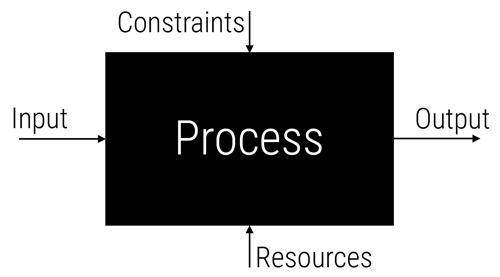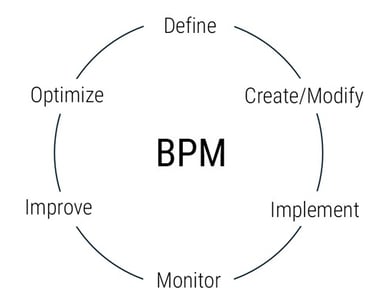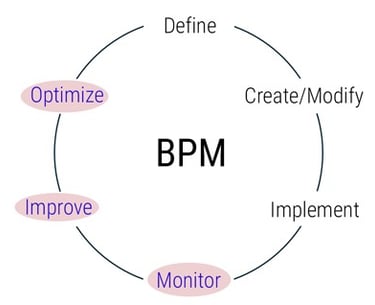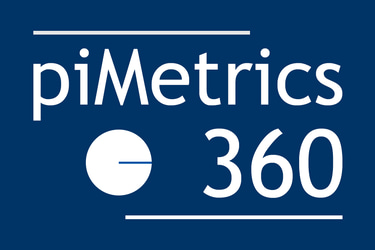Gain insights into the power of automated process efficiency diagnostics.
Operational Process Efficiency Diagnostics Insights
OPE-002: Automation of Business Process Management (BPM)


What is BPM?
A business process is a form of an operational process that exists within the context of a business environment. An operational process, in turn, is a collection of activities used to create or produce something of value using specific resources over a period of time. The creation or production of value usually involves transformation of one or more input material and/or information using these designated resources. The item of value that is created or produced is referred to as the output of the process and such item (a form of product, good, information, or service) is typically provided or sent to a recipient (of the process) ― such as a colleague, a stakeholder, a customer, a third party, or perhaps another process. An operational process does not function without limits, but rather within an environment that presents constraints. These constraints can and do change over time and include business policies, regulatory requirements, governing laws, technology, or technical limitations, and more.


Business Process Management (BPM) refers to a system (or a discipline) that is focused on defining, creating, modifying, implementing, monitoring, improving, and optimizing business processes so that these processes align with business goals and objectives, perform in a timely manner, consume minimal resources, and adapt to a changing environment, while maintaining or enhancing value.


Value of BPM
Business Process Management is a vital part of the capabilities of an organization that is focused on its customers. Strong BPM enables an organization to continually produce quality products, goods, and services. It also enables an organization to deliver its quality products, goods, and services to customers in a timely manner. Effective BPM enables an organization to continuously operate at a high level of efficiency and productivity.
Importance of BPM
By examining the focus elements of Business Process Management, the importance and additional value of this system emerge.
Define: definition (for a new process) begins with the identification of a business need to ensure that the process will align with the strategy, business goals, and objectives of the organization. This implies that the (new) business process will function in a manner that supports the stated direction of the organization. On the other hand, for an existing process, definition involves discovery of a process, along with its underlying activities and workflow, to determine its current scope of usage. This is typically accomplished through a process-mapping exercise.
Create / Modify: the capability to create and modify the activities, and the workflow of those activities, that make up a business process, enable an organization to support, and maintain a consistent standard of work. A consistent standard ensures consistency of the quality of output from the process. Also, the ability to modify an existing process ensures flexibility and adaptability, particularly in a changing business environment with dynamic constraints.
Implement: this component (of BPM) refers to the ability to execute (or operate) a created, or modified, business process so as to achieve the goals and objectives of the organization. This involves deployment and engagement of resources necessary to perform the process. These resources can include staff, computer equipment, software systems, machinery, instructions, training programs, and a variety of other tools. Implementation also involves creation of audit logs that capture and document the workflow of activities as the process functions. These logs, if documented properly, facilitate effective process monitoring.
Monitor: the capability to monitor (a process) refers to the ability to capture data and measure the behavior and performance of the process after implementation. Monitoring provides visibility into the way a process behaves to determine whether it is performing as designed, as created or as modified. Monitoring also involves measuring specific metrics and indicators that reveal the performance of a process. Effective monitoring further exposes bottlenecks in the workflow of process activities, as well as potentially wasteful or inefficient use of resources ― all of which undermine productivity of the process and increase the process operating cost.
Improve: this component (of BPM) refers to the ability to evaluate, determine and make meaningful modification to a business process in response to a variety of factors such as redundant process activities, discovered bottlenecks, wasteful use of resources, as well as changes in constraints associated with the business operating environment (e.g. regulatory requirements, governing laws, business policy, etc.) The general objective of improvement is to reduce process completion time, reduce cost, and maintain or improve quality of (the process) output.
Optimize: the capability to optimize (a process) refers to the ability to continually make meaningful modification to a business process through incremental efforts for the purpose of achieving the best operating levels possible to reduce process completion time, reduce cost, and maintain or improve quality of (the process) output.
BPM in the Era of AI
Today, business processes are increasingly enabled by technology ― in part or in whole. This makes Business Process Management a vital capability for every business organization. An effective BPM practice drives an organization to remain operationally efficient and highly productive, while reducing cost. BPM can close a competitive gap or can afford an organization a competitive advantage.
However, BPM can be very cumbersome and time-consuming without the aid of technology. Business organizations maintain tens, hundreds and, in some cases, thousands of operational processes across their enterprise domain. Implementing BPM across a medium to large enterprise domain is a daunting task.
Technology tools that enable automation of one, or more, or all phases of BPM are necessary to ensure active, effective, and sustainable BPM practice. Technology tools that incorporate the use of Machine Learning (ML) and Artificial Intelligence (AI) will prove most attractive among BPM enablers.
piMetrics360 and BPM
piMetrics360 is an innovative AI-ready technology software platform that brings the power of automated, cutting-edge operational process efficiency diagnostics into the realm of Business Process Management. piMetrics360 drives, accelerates, and sustains BPM in transformational ways by automating much of the last three phases of the BPM lifecycle ― Monitor, Improve, and Optimize.
These features position piMetrics360 as an independent, AI-Ready, process efficiency diagnostics software platform of choice to employ alongside leading enterprise process automation workflow software platforms.
An innovative enterprise architecture that tracks business processes across each and every level of a multi-tier enterprise domain (such as an organization with a parent entity along with multiple subsidiary entities),
Automated, rapid, data-driven process efficiency diagnostics engine that monitors 100’s and 1,000’s of operational processes concurrently,
Advanced analytical tools that automatically uncover process bottlenecks and identify sources of inefficiency,
Automated process efficiency metrics, along with efficiency indices, including the prominent Relative Efficiency Index, which enable process efficiency degradation early detection,
Automated, advanced analytics that provide multi-dimensional efficiency insights that drive continuous process improvement planning and implementation, and
Automated internal process efficiency benchmarking that drives operational excellence.
piMetrics360 features that drive these latter BPM phases include:


